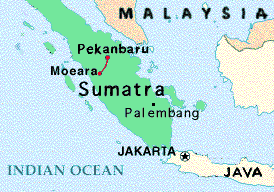
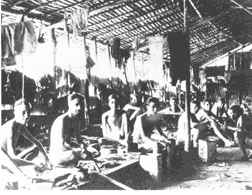
Life and Death on the Death Railway Through the Jungle of Sumatra
by George Duffy
Whenever an American Fire Department or Police Department is struck by tragedy, as happened in the Massachusetts cities of Worcester and Holyoke this past December 1999 when six firefighters and one police officer were killed while performing their duties, the outpouring of public grief and sympathy is overwhelming. Thousands of their fellow officers, from all over the United States, including bagpipe bands and color guards, travel to pay their last respects and take part in the funerals and memorial services.
On such occasions my thoughts always revert to the last twelve months before the Japanese surrender in World War II. In those days I, and about 5,000 Allied military personnel -- mainly Dutch and English, but including a little over 200 Australians and 15 Americans, were held as prisoners of war by the Japanese. We were engaged in the building of a narrow-gauge railway across the central portion of the island of Sumatra, in what is now known as Indonesia.
The northern terminal of the railway was the city of Pekanbaru (new spelling), therefore the project became known as the Pekanbaru Rail Line. In more recent years, a Dutch author dubbed it "The Death Railway Through the Jungle."
 |
 |
| The route of the Pekanbaru Rail Line in red | Inside the barracks at Base Camp - photo source unknown |
Indeed death was no stranger there. We were overworked, underfed, provided with little medicine, and subjected to constant physical and mental abuse by our Japanese overseers.
A hospital for malaria, dysentery, pellagra, and beri-beri patients existed in name only. It was simply a dilapidated bamboo-framed, thatched roof barracks where the sick were placed to await their eventual death. Once in a while, a man recovered his health and returned to the daily camp routine, but it was not the rule.
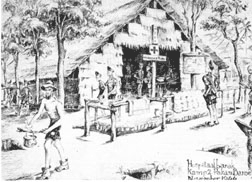 |
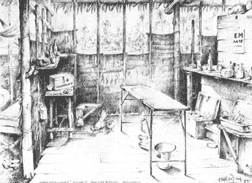 |
| The Base Camp "hospital" - sketch by F.A.R. de Jong, Amsterdam | "Where the doctors carried out their mostly hopeless struggle against death" - sketch by F.A.R. de Jong, Amsterdam |
In April 1945, I was living and working in the Base Camp which contained this "hospital." Deaths that month (according to my journal) totaled 106; an additional 14 died out in the construction camps along the line. My job, with 29 other officers, was to cut down rubber trees and carry the logs into camp. There, another group sawed and split them for the cookhouse and the locomotives. (That's right: wood-burning boilers!) Rarely did the full complement of 30 report for work. Everyone was afflicted with malaria which reduced our number to about 20 on a given day.
We worked in teams of three - an axe man, and two carriers. Rubber trees grow tall and straight. The wood is fairly soft - and wet. Each of us became quite adept at felling a tree and we even had contests to see who could most accurately predict the line of fall. One man chopped while the other two went in and out of the camp. Burlap bags were used to protect the log carriers' shoulders and also to hide the occasional dried fish, fruit, or vegetables purchased from a passing native vendor. (Such food was available, but the Japanese would not buy it or requisition it, and actually attempted to prevent us from "smuggling" it into camp.)
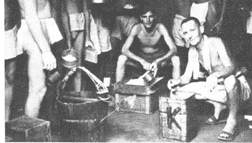 |
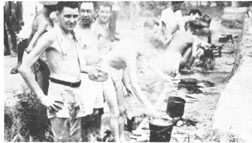 |
| "Food distribution is the high point of the day" the wooden containers held rice, the tin held stew - photo from Australian War Memorial, Canberra | "Prisoners cook their own pots of purchased or smuggled ingredients because the official rations were insufficient" - photo from Australian War Memorial, Canberra |
Therefore, the "wood party" offered an invaluable, though risky, opportunity for its members to create a "black market" inside the camp. We always had a single guard with us. Due to the nature of the work, we were spread through the plantation, so most of the Japs simply spent the day sitting by our camp fire reading the pornographic books they all carried, or snoozing.
The railway workers carried their mid-day meal with them when they left in the morning. We on the "wood party" came into camp at noon for our meager cup of steamed rice and a watery soup made of tree leaves. Before we went to work in the afternoon someone from the "hospital" would tell us how many deaths had occurred in the previous 24 hours. For each deceased, four of us would be detailed to carry the straw-matting wrapped body to the cemetery which was adjacent to the plantation where we chopped down the trees. Out of respect for the dead, we covered our nakedness with a shirt or jacket. (The sole, daily item of wearing apparel was a Japanese-style loin cloth.)
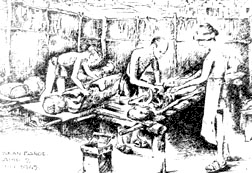 |
Every evening after the dead were collected in the roofless barrack extension, their remains were wrapped in a straw mat preparatory to burial"- sketch by F.A.R. de Jong, Amsterdam |
Several prisoners labored at the unending task of digging the graves and burying the remains. Most of the time we never knew the identities of the lost souls who we carried over the creek and up the hill. Only if a prisoner had five friends was he accorded a proper burial, generally at the end of the work day.
Such was the case on May 29, 1945, less than three months before V-J Day. Sidney M. Albert, one of the cooks on our ship, the American Leader, had died. In the evening, Stan Gorski, our ship's bosun, a U. S. Marine, an English soldier, and I, were the pall bearers. Another shipmate, Carl Kalloch, carried the shovels and the cross.
All clergy had been left behind on Java when we came to Sumatra, thus the committal service for anyone off my ship became my responsibility. It was brief. The Lord's Prayer. The 23rd Psalm, read from a borrowed Bible. Lower the body. Fill the hole. Erect the wooden cross, and, under the watchful eyes of the Jap sentry, trudge back to the gate and get inside the barbed wire before dark.
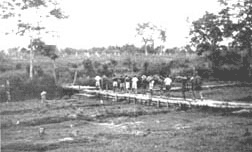 |
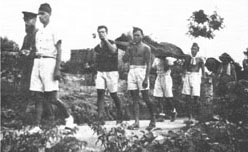 |
| Funeral procession crossing the creek - photo from Australian War Memorial, Canberra | Australians and Dutch participate in a funeral - photo from Australian War Memorial, Canberra |
The cause of Albert's death was malnutrition, or as it was called out there, "beri-beri." Lack of protein and vitamins caused kidney malfunction which resulted in fluid retention. A victim would first notice a soft swelling of his hands and feet which eventually progressed to his torso. He ballooned in size to as much as 250 to 300 pounds, losing mobility, and putting a severe strain on his heart. Albert was a load.
My exertion in carrying him to his burial site so sapped me that the next day, according to my journal, I suffered "the worst attack of malaria that I've had yet. I worked for 31 days without a break, most of the time axe work, and when the 'old bug' hit, I went down for the count. The whole packet -- fever, chills, and sweats. I never imagined it could be so bad".
Albert was 49. The average age at death of the 700 who perished on that railway was 37 years and 3 months. Five were 57, one was 58, another 66. They probably had wives and children -- somewhere. Yet most of them when they died had not five friends to mourn for them.
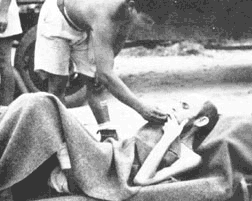 |
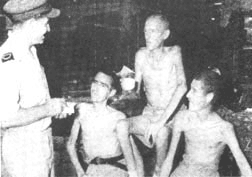 |
| Awaiting evacuation- photo from Australian War Memorial, Canberra | POW's arrive in Singapore - unknown Singapore newspaper |
On Sumatra there were no columns of fellow soldiers, sailors, or airmen. There were no color guards. On Sumatra there were no pipers nor drummers. No flowers. No eulogies. Death on Sumatra rarely arrived as a thunderclap. It moved slowly and inexorably through the "hospital." The men who died knew it was coming, and there was nothing to prevent it.
It is a great mystery, isn't it? The 700 unfortunates of Sumatra are just as dead as the 6 Worcester firefighters and the Holyoke police officer. By comparison, though, how fortunate were these latter 7 men to have had their lives celebrated with such pomp and ceremony. How fortunate were their families to witness the out-pouring of pride and devotion and brotherhood exhibited by their men's peers. How fortunate are we all to be living in a civilization that prides itself on such responses.
How fortunate that we won the war!
Postscript: Comparison between death rates of British and Dutch POWsWhen I was doing the research for the above article I picked up the thread of a thought that has been in my mind for many years. I have long felt that there were links between death rates, ages and nationalities on that railway job. Not until recently, however, did I bother to do a detailed study. First of all, a look at central Sumatra, the prison camps and their society.
The plan was to create a 138-mile connection between the town of Pekanbaru and an existing rail line which ran to the city of Padang on the Indian Ocean. Pekanbaru is located in the center of the island at latitude 0 degrees, 39 minutes north, thus 39 nautical miles above the equator. It was a small seaport, connected via the Siak River to the Strait of Malacca. Much of the surrounding terrain was swamp, with numerous interlaced waterways, creeks and bayous. It was a terrible area on which to build railbeds, bridges and to lay tracks.
Fifteen miles or so south of the town the ground was more stable, but the mangroves were replaced by a huge, dense, towering jungle, complete with wild tigers and elephants. Compounding the prisoners' problems was the extreme equatorial heat and the rains of the spring monsoon.
From May to September 1944 the Japanese threw into this inhospitable corner of the earth somewhat over 5,000 Allied prisoners who they had captured on Java two and a half years earlier. Of that number almost 4,000 had been in the Royal Dutch Indies' Army and close to 1,000 were British Army, Navy and Air Force personnel. Additionally, 200 Australians and 15 Americans, mostly merchant seamen whose ships had been sunk by a German raider, rounded out the total.
Unfortunately, considerable rancor existed between the various nationalities. The British and the Australians were never friendly, even before the war. That tenor actually went back to the 1700s when Australia was colonized by British emigrant prisoners. The numerically superior Dutch were disliked by both the Brits and the Aussies on the grounds that the Dutch in the East Indies, without a fight, had capitulated to the Japanese. In return, the Dutch pointed to the British surrender of Singapore.
Numerous of the European Dutch spoke English, but there was no more than a handful of English or Australian officers -- never mind the soldiers -- who knew any Dutch. This spilled over into frequent confrontations and even brawls. Meanwhile, everyone contracted malaria; many suffered with dysentery; and tropical ulcers -- a gangrenous condition -- disabled others. The fact that the food ration was barely life-sustaining overshadowed everything. As early as Dec. 31, 1944, 125 prisoners had expired.
After the last prisoner was repatriated, one historian shows the following death rates:
No.
in camp |
No.
died |
Average
age at death |
Comment | |
| Dutch | approx. 4,000 | 513 (13.3%) | 40 | 328
(64%) of dead aged 37 to 51; 14 men over 51 |
| British | approx. 1,000 | 151 (16.8%) | 30 | 103
(60%) of dead aged 21 to 37; 46 men were 23 to 26 |
| Total | 5,076 | 704 (13.9%) | - |
As the Americans and Australians composed just 4 percent of the work force, they are not included in this study.
Those are the numbers that reinforce my long-held opinion: To supplement what little the Japanese gave us, the young Dutch successfully used their knowledge of the indigenous grasses, roots, mushrooms, nuts, etc. to win the battle of survival. Chauvinistically, they kept what they knew to themselves. Being at that time quite fluent in the Dutch language, I had become a member of their society and learned from them.
Another example of chance favoring the prepared mind.
All photographs were made after liberation of the camp.Sources for illustrations:
All photos and sketches are from the book by Henk Hovinga: "Eindstation Pakan Baroe 1943-1945 - Dodenspoorweg door het oerwoud" (ISBN 90 6064 922 2. Fourth edition 1996, Amsterdam. 344 pages.) An extended English translation of this book called: "Final Destination Pakan Baroe 1943-1945 - Death Railway Through Jungle" on CD with 162 illustrations, may be ordered by e-mail from the author: >henk.hovinga @ tiscali.nl<. Price is US $ 40.00 including shipping and handling.Sumatra map adapted from http://www.lib.utexas.edu/Libs/PCL/Map_collection/cia99/Indonesia_sm99.jpg
A similar version of this story appeared in The Daily News of Newburyport, Massachusetts
Write to Captain George Duffy
Other articles by Captain Duffy Captain George Duffy's Home Page
Home
POW4/7/00